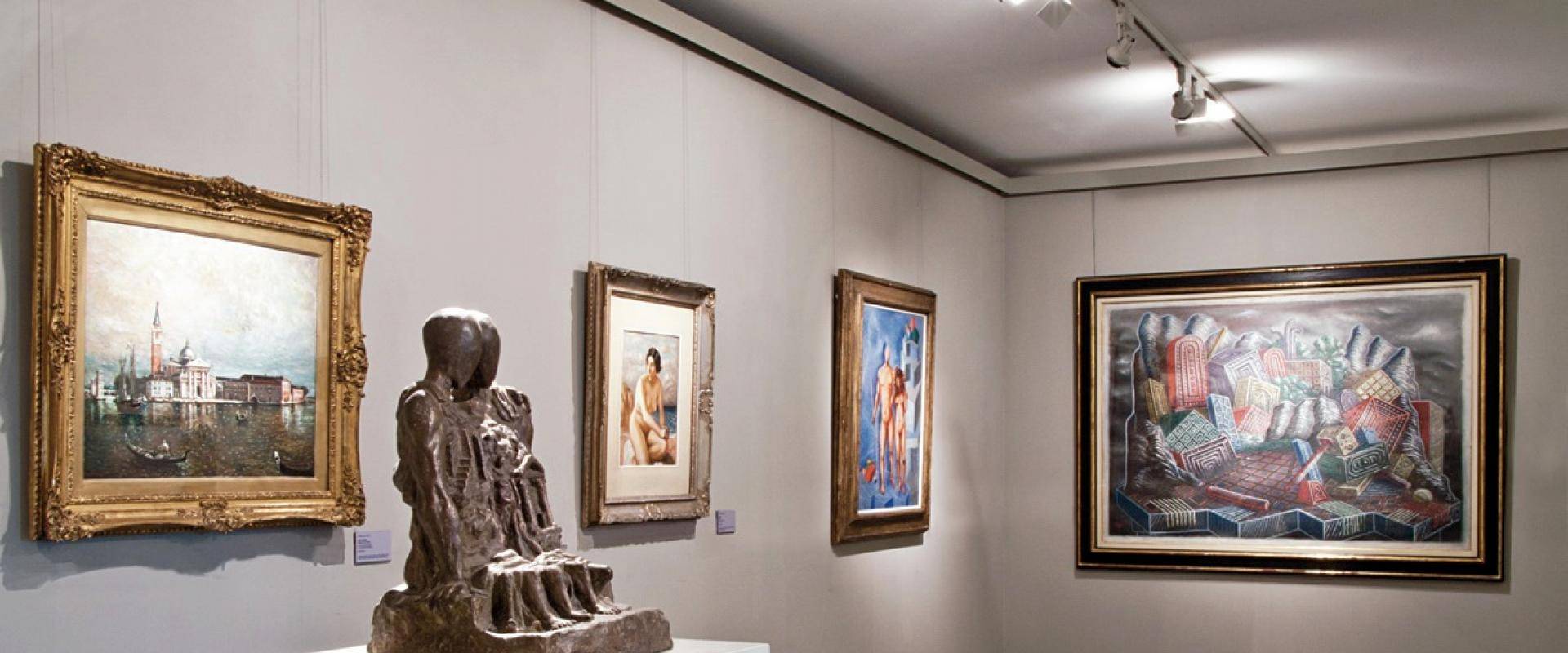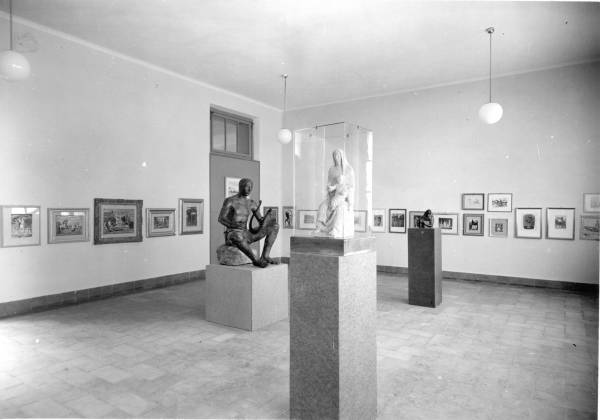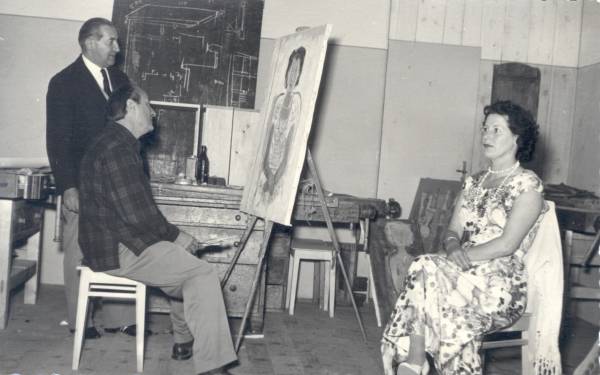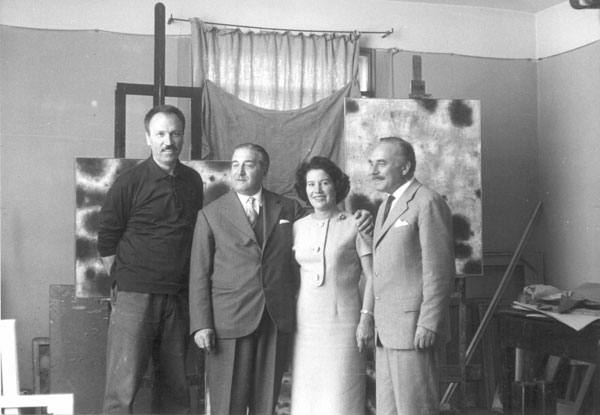To access this section of the website you need to be registered

Between the twenties and thirties the young masters were spotted by indifference. There was no cultural understanding of the quality of modern art and only painters consolidated by history were valued. Furthermore, public institutions, slow and uncertain in purchasing, were replaced by private individuals, pure enthusiasts, amateurs in art criticism.
Rimoldi was one of them. His first purchases fall within the nineteenth-century tradition of Italian painting, but soon telegrams from the artists he hosted will appear on the walls of the tourist agency he manages at the Hotel Corona.
The works tend to be personalized: the painters are invited by the collector to paint, for example, portraits or landscapes as they wish. Not everyone is inspired by the valley that hosts them, but everyone illuminates it with the fruit of their personal genius.

With the arrival of de Pisis, the fusion between the work and the Ampezzo landscape became perfect: his talent was inspired by the particular beams of the Alpine buildings, the distinctive features of the pastures, the fir trees, the bell tower. de Pisis, an international artist, but linked to the Venetian environment through Cadore and Venice, becomes the main author of the Rimoldi collection and the connection with the Parisian artistic environment.
In addition to the artists who travel to Cortina, the collector finds a rich source of updates and information for purchases at the Venice Biennale. In 1941 the collection was defined in its substantial imprint and reached a prestigious value. The splendid de Pisis, Morandi and Semeghini stand out. With the works of Rosai, Campigli, Sironi, Garbari, Severini, Tosi and Guidi the picture of the painting of the masters of the years before the 1940s is much more complete than in most public galleries.
The panorama expands with the sculptures of Martini, Marini and Sironi. Post-World War II painters, including Vedova and Santomaso, before their fame was recognized, soon joined the group.
In the exhibition staged at Cortina in 1941, the packed list of Italian names is indicative of Rimold's choices. Of the thirty-two Italian artists, over half are from Veneto (Martini, Juti, Ravenna, Rossi) or tied to the Venetian school (Carena, de Pisis, Moggioli, Semeghini). de Pisis occupies a lead role, with works which, though centred on subjects stretching from Cortina to Rimini, also include Milan, Venice and Paris paintings. The pictures in the collection represent the best works produced in Italy in the years between the two wars and Veneto is, from this point of view, a stimulating observatory centred on the Italian art of that period.
After the war, we began to see the extraordinary openings offered by the Venice Biennale, which pushed Rimoldi to attend the first major modern art exhibitions, with frequent visits to Paris too. Thus he discovers the historical avant-gardes and, to give a broader image of the artistic world, the experimental works of artists already represented with figurative paintings such as Severini, Sironi, Soldati, Savinio enter the collection.
The patron thus continues to gather the great names of the early twentieth century including Campigli, Carrà, de Chirico, de Pisis, Guidi, Morandi, Rosai, Severini, Sironi and Tosi and, furthermore, he is interested in artists linked to the figurative genre, promoted not least for their links with the Venetian environment, such as Cadorin, Cesetti, Saetti, Tomea, Depero.
However, there are also wide openings towards new movements that are forming outside the Veneto.

New additions to the collection are Guttuso's La Zolfara (a painting for which R. refused offers from the Hermitage at Leningrad) and the protagonists of new experimentation, such as Corpora, Crippa, Dova, Morlotti, Music, Santomaso, Vedova.
Rimoldi also discovered new foreign artists such as Kokoschka, Leger, Villon, Zadkine, and was starting to take an interest in the new avant-garde and the abstract artists of the Fifties, with the aim of creating a complete American-type collection of the major artists of his age.
That he had made the right decision was confirmed by the fact that English and US galleries were making high bids to purchase his works. Becoming part of the collection was virtually a sign of official recognition for artists.

Precisely on the model of the great European collecting, the inexhaustible creator of public galleries, the intention to link the collection to Cortina, keeping it together in a public gallery, was increasingly apparent. Mario Rimoldi's final act was, in fact, having arranged the donation - which was carried out in 1974 at the hands of his widow Rosa Braun - of the cream of his collection to the Regole d'Ampezzo.
The result was an art gallery that would honor any large city: the collection is considered, in fact, one of the best expressions of twentieth-century Italian painting. Among the cornerstones of modern painting in Italy, in addition to the 54 by de Pisis, Le Bagnanti by Carena, Semeghini's Squero di San Travaso, Guttuso's La Zolfara, Garbari's San Sebastiano, Savinio's Ile des charmes and Il Concerto stand out of Campigli.
In the following years, numerous donations enriched the museum, including a testamentary donation of around 311 works by Alis Levi.
Well-known artists have paid homage to their creations: this is the case of Music, Gard, Madiai, De Stefano, Gonzales, Seppi, Barbarigo.